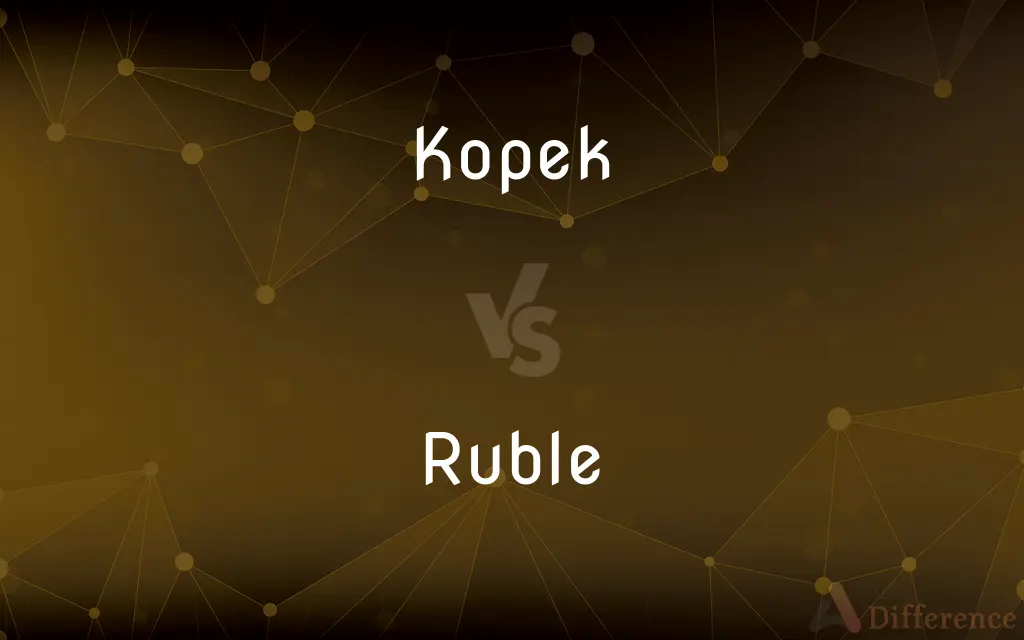Kopek vs. Ruble — What's the Difference?
By Fiza Rafique & Maham Liaqat — Updated on May 2, 2024
A kopek is a monetary subunit of the ruble, worth one hundredth of a ruble; the ruble is the primary currency unit of Russia.

Difference Between Kopek and Ruble
Table of Contents
ADVERTISEMENT
Key Differences
A kopek represents a smaller denomination in the Russian monetary system, specifically being one hundredth of a ruble. On the other hand, the ruble serves as the base currency unit, used in larger transactions and as a standard reference in pricing.
While kopeks are used primarily for small, everyday transactions due to their low value, rubles are more commonly used for higher-value purchases and official pricing in markets and governmental transactions.
Kopeks are less frequently used in physical form today, particularly as inflation has reduced their purchasing power. Conversely, rubles are more prevalent in both digital and physical forms, adapting more dynamically to the modern financial environment.
In financial accounting and pricing, prices might be set in rubles with kopeks used to provide precise amounts, showing the interdependent relationship between these units. Whereas rubles can stand alone as a pricing metric, kopeks rarely appear without reference to rubles.
The production and circulation of kopeks are influenced by economic factors such as metal prices and demand for lower denomination coins. Rubles, on the other hand, encompass a wider variety of banknotes and coins, reflecting broader economic policies.
ADVERTISEMENT
Comparison Chart
Denomination
One hundredth of a ruble
Primary currency unit
Usage
Small transactions, less common today
Common for all types of transactions
Form
Mainly coins
Coins and banknotes
Influence by Economy
Lower demand, less frequently produced
Broadly used, more dynamically influenced
Relation
Subunit of ruble
Comprises kopeks and larger denominations
Compare with Definitions
Kopek
Smallest denomination in the Russian currency system.
He handed over a few kopeks for the candy.
Ruble
The basic monetary unit of Russia.
She exchanged her dollars for rubles upon arriving in Moscow.
Kopek
Typically produced as coins.
The new kopek coins were introduced last year.
Ruble
Can exist without subunits in transactions.
The total bill came to exactly 200 rubles.
Kopek
A monetary subunit of the ruble worth one hundredth of it.
The price was marked as 59 rubles and 99 kopeks.
Ruble
Used widely in all financial dealings in Russia.
The apartment costs 750,000 rubles.
Kopek
Rarely used in modern Russia due to low value.
Kopeks are often not accepted in digital transactions.
Ruble
Adjusts to economic changes and inflation.
The ruble has depreciated significantly this year.
Kopek
Represents minimal economic transactions.
Only a couple of kopeks were added as tax.
Ruble
Issued in both coins and banknotes.
He pulled out a ten-ruble note to pay.
Kopek
The kopek or kopeck (Russian: копейка, IPA: [kɐˈpʲejkə], Ukrainian: копійка, Belarusian: капейка) is or was a coin or a currency unit of a number of countries in Eastern Europe closely associated with the economy of Russia. It is usually the smallest denomination within a currency system; 100 kopeks are worth 1 ruble or 1 hryvnia.
Ruble
The ruble or rouble (; Russian: рубль, IPA: [rublʲ]) is the currency unit of Russia and some states in Eastern Europe closely associated with the economy of Russia. As of 2022, the three variants of rubles in circulation are—the Russian ruble (RUB, ₽) in Russia, Abkhazia and South Ossetia, the Belarusian ruble (BYN, Br) in Belarus and the unrecognised Transnistrian ruble in Transnistria.
Kopek
A Russian unit of currency equal to 1/100 of the ruble.
Ruble
See Table at currency.
Kopek
A Russian monetary unit equal to one hundredth of a ruble.
Ruble
The monetary unit of Russia, Belarus and Transnistria equal to 100 kopeks (Russian: копе́йка, Belarusian: капе́йка). The Russian ruble's symbol is ₽.
Kopek
A kopiyka: a Ukrainian monetary unit equal to one hundredth of a hryvnia.
Ruble
The unit of monetary value in Russia. It is divided into 100 copecks, and in the gold coin of the realm (as in the five and ten ruble pieces) is worth about 77 cents. The silver ruble is a coin worth about 60 cents.
Kopek
100 kopecks equal 1 ruble
Ruble
The basic unit of money in Tajikistan
Ruble
The basic unit of money in Russia
Common Curiosities
Can you only use rubles in Russia?
Primarily, the ruble is the official currency used throughout Russia.
What is a kopek?
A kopek is one hundredth of a ruble, the smaller currency unit in Russia.
How does inflation affect kopeks?
Inflation decreases the purchasing power of kopeks, making them less useful.
Are kopeks still used in Russia today?
Yes, but they are much less common due to their low value and limited purchasing power.
Is there any situation where only kopeks are used?
Rarely, as their value is very low, but they might be used for very small transactions or as change.
What is the largest denomination of ruble currently in circulation?
Banknotes of rubles can go up to 5000 rubles.
How many kopeks make up a ruble?
There are 100 kopeks in one ruble.
What is the primary use of rubles in Russia?
Rubles are used for all commercial and personal financial transactions.
What denominations are available for rubles and kopeks?
Rubles are available in various denominations of both coins and banknotes, whereas kopeks are mostly coins.
Do prices in Russia include both rubles and kopeks?
Yes, prices can be listed with both rubles and kopeks for precision.
Share Your Discovery

Previous Comparison
Anticipate vs. Participate
Next Comparison
Commission vs. MissionAuthor Spotlight
Written by
Fiza RafiqueFiza Rafique is a skilled content writer at AskDifference.com, where she meticulously refines and enhances written pieces. Drawing from her vast editorial expertise, Fiza ensures clarity, accuracy, and precision in every article. Passionate about language, she continually seeks to elevate the quality of content for readers worldwide.
Co-written by
Maham Liaqat















































